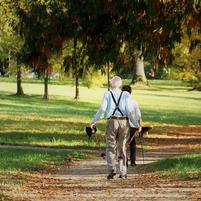When cities get it right in terms of planning and design for health, chief among the beneficiaries are older people. We all recognise what an urban environment that supports better health looks and feels like. Walking, cycling and public transport reduce over-reliance on car travel; effective resilience planning stops the spread of infectious diseases and mitigates the effects of climate change; flexible work strategies reduce stress and gridlock; access to safe, affordable housing, green spaces and healthy local food underscore a commitment to community wellbeing. As a result, a big weight is lifted off formal healthcare services as cities get on the front foot with a proactive stance on health.
But, equally, when cities get in wrong on health, the alternative vision is dystopian: in this scenario, air quality (already unacceptable in many cities) becomes more dangerous as commuters, cars and delivery vans clog up the roads; climate change threatens more than 500 hundred cities with flooding and many more with water shortages and heatwaves more intense and longer lasting than ever before; tensions rise between well-heeled business districts and areas of urban deprivation that ring them; ‘food deserts’ increase and green spaces are gobbled up by development. As a result, healthcare services are put under exceptional pressure. Cities switch to reactive and even crisis mode on health.
As many older people are likely to be disproportionately disadvantaged by poor air, poor food, vehicle accidents, social isolation and urban alienation, we all know which utopian scenario we’d prefer – and which nightmarish outcome we are desperate to avoid. The trouble is that too many cities around the world – especially in polluted Asian urban centres – are falling into the trap of investing in healthcare to fix the ills caused by a generally unhealthy environment rather than developing a whole-picture approach to health. As a result, the drive to enlist urban planners, architects, public health professionals and researchers of all stripes to create healthier cities has reached a crossroads in which competing utopian and dystopian visions stretch before us.
How can we head off down the right road rather than take a wrong and potentially dangerous turn? This was the subject of the third annual Healthy City Design International Congress, held in London on 14-15 October 2019. I am the academic chair of the Congress, which is a partnership between the Royal College of Art’s Helen Hamlyn Centre for Design and Salus Global Knowledge Exchange.
While there were specific papers devoted to the health impacts of various planning and design decisions on older adults, what really struck me this year was the universality of solutions being proposed by some of the world’s leading experts in this area. Healthy cities are, quite literally, for everyone – not just for pensioners or children or commuters or other special groups.
I particularly liked a slogan for more resilient urban communities advanced by Mark Johnson of American urban designers Civitas - ‘go green and get moving’. Johnson has built a much-lauded career on the principles of designing high-quality, green public space within ready walking distance of people’s homes. Currently he’s working with US actress and songwriter Bette Midler on a project at Mott Haven in the South Bronx area of New York to implement physical changes that improve health, wellbeing and safety for everyone. Mott Haven has 15,000 people living in an area considered the worst place for asthma in the city. It has the highest mortality rate in the state, one of the highest rates of vulnerable populations, and highest rates of heart attacks and pedestrian injury. Forty-five per cent live in poverty, 71 per cent are obese, and crime rates are at excessive levels.
Johnson’s plan for change in the area connects an entire circuit of trails and park spaces in order to increase the amount of time people spend walking outdoors and build community participation. ‘Go green and get moving’ may appear to be one small, simple slogan but there is a great deal of scientific evidence sitting behind it. Could Mott Haven, with its seemingly insurmountable obstacles, become a symbol for healthier city districts in the future? As we contemplate the fork in the road, one would like to think so.
About the Author
Jeremy Myerson is Helen Hamlyn Professor of Design at the Royal College of Art and an Honorary Visiting Fellow at Oxford Institute of Population Ageing.
Comments Welcome
We welcome your comments on this or any of the Institute's blog posts. Please feel free to email comments to be posted on your behalf to administrator@ageing.ox.ac.uk or use the Disqus facility linked below.
Opinions of the blogger is their own and not endorsed by the Institute
Comments Welcome: We welcome your comments on this or any of the Institute's blog posts. Please feel free to email comments to be posted on your behalf to administrator@ageing.ox.ac.uk or use the Disqus facility linked below.













